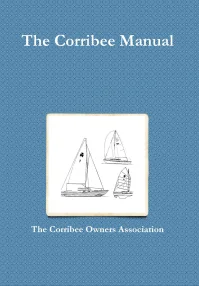Duckboards
Alan McKeand writes:
If like me, you may spend a few hours in the cockpit when making a relatively long passage in British waters, your feet can become quite cold (even when wearing thick socks and sea boots in summer!) due to their immersion in sea water sloshing about on the cockpit sole. Because the level of the cockpit sole in the Corribee is only slightly above the waterline, the ingress of some sea water cannot be avoided when under way especially if there is any degree of heel on the boat even though the cockpit is self-draining.
The best solution to this problem is to fit a duckboard on the cockpit sole which will keep your feet above most of this water. Ideally, the duckboard should be made of teak but this wood is very expensive even if you are lucky enough to find a supplier. A cheaper and very practical alternative is to use plastic which is totally resistant to sea water and a search on the internet will reveal a few firms producing ready-made plastic duckboards, e.g. the “Safe-T-Grid” range manufactured by Jaymart of Westbury, Wiltshire (www.jaymart.co.uk). The main disadvantage here, however, is that you have to buy a 10m roll of the stuff which rules it out on cost grounds. Moreover, I feel that the thickness of just 16mm is not really sufficient for our purposes.
I have therefore decided to knock together my own tailor-made duckboard from 22mm diameter white plastic pipe (available from most DIY stores such as Focus, B&Q etc.) cut into lengths corresponding to the length of the cockpit sole. Two lengths of the pipe on each side of the duckboard have been cut approx. 6cm shorter than the others in order to leave the cockpit drains clear. All these lengths of plastic pipe were then drilled through the middle at 5cm intervals to take shorter lengths of 8mm diameter grey PVC rod to form the cross members (this latter material is available in small enough quantities from Direct Plastics (www.directplasticsonline.co.uk). Finally, I have sealed the ends of each plastic pipe with rubber caps of 22mm internal diameter to keep most of the water out so that the duckboard will be buoyant enough to float if it should accidentally fall overboard. The attached photos show the completed duckboard.
Contribute
Do you have a story, information, brochure, manual, link or other relevant content that should be on this page? If so, we would be very grateful if you would leave it as a comment or email corribeeeditors@googlemail.com so we can post here – thanks!





October 7, 2014 at 12:25 |
(Editors note – This comment has been approved as it might possibly be useful to Corribee owners. However, we have no personal knowledge of this product or the company. Please do your own research.)
Hi – Why not try our pvc interlocking duckboard tiles – 10 colours available – search for anti-slip matting uk or just go to the safe on-line website http://www.anti-slip-matting.co.uk – free samplers sent out – no obligation to buy – free quotes.
May 7, 2011 at 09:00 |
Hi
Great idea. Where did you get the rubber caps from?
Thanks
Darren
May 21, 2010 at 10:20 |
Further information on duckboard construction in response to Jay Blackburn:
1) SPACERS
In order to hold the 8mm plastic rod cross members in place, you also need to push a short piece of 8mm internal diameter flexible transparent tubing (say about 15mm long) on each end of the rods. This will be made easier by smearing a thin layer of vaseline or other lubricant on the rod ends. I have left about 1-2mm of this tubing projecting clear of the rod ends to prevent the harder PVC rod from scratching the sides of the cockpit as the flexible tubing is a softer material.
2) SPECIFICATION OF WHITE PLASTIC PIPES
The 22mm white plastic pipe I used to make the longitudinal sections of the duckboard has the following specification actually printed on the outside:
22mm PE-X barrier BS7291
The Focus nationwide DIY chain sells this product in 2m lengths (some online suppliers, as well as some small DIY shops, sell it in longer lengths).
The abbreviation PE-X stands for cross-linked polyethylene and this type of pipe is normally used for hot or cold water in vented and sealed central heating systems.
3) TOTAL COST OF MATERIALS FOR DUCKBOARD
The total cost for all the materials used to make my duckboard came to less than £45.
Best regards
Alan
May 19, 2010 at 21:14 |
THats Great Alan I just love the idea. I made one of Idigbo but it was so heavy, this seems great !!
May 18, 2010 at 21:56 |
Looks a great idea – How do you keep the pies equally spaced Did you make up spacers or are they glued please
Thanks a lot
Jay
May 19, 2010 at 08:48 |
Reply to Jay Blackburn re Duckboard for the Corribee:
I used spacers cut from 10mm internal diameter transparent plastic
tubing which slide easily over the 8mm diameter grey PVC rods forming the cross members. These were placed only on the rods at each end and in the middle of the duckboard as this was sufficient to give it the necessary stability.
Kindly note also that the duckboard tapers from one end to the other in order to fit the cockpit sole so that the spacers have to be cut at slightly different lengths. Hope this helps.
Kind regards,
Alan